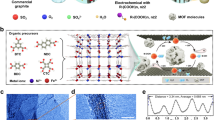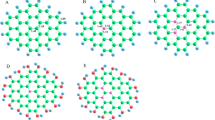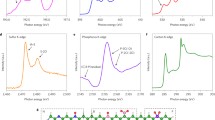Abstract
Water electrolysis is to split water into hydrogen and oxygen using electricity as the driving force. To obtain low-cost hydrogen in a large scale, it is critical to develop electrocatalysts based on earth abundant elements with a high efficiency. This computational work started with Cobalt on CoTa2O6 surface as the active site, CoTa2O6/Graphene heterojunctions have been explored as potential oxygen evolution reaction (OER) catalysts through density functional theory (DFT). We demonstrated that the electron transfer (δ) from CoTa2O6 to graphene substrate can be utilized to boost the reactivity of Co-site, leading to an OER overpotential as low as 0.30 V when N-doped graphene is employed. Our findings offer novel design of heterojunctions as high performance OER catalysts.
Similar content being viewed by others
References
M. G. Walter, E. L. Warren, J. R. McKone, S. W. Boettcher, Q. Mi, E. A. Santori, and N. S. Lewis, Solar water splitting cells, Chem. Rev. 110(11), 6446 (2010)
H. Dau, C. Limberg, T. Reier, M. Risch, S. Roggan, and P. Strasser, The mechanism of water oxidation: From electrolysis via homogeneous to biological catalysis, ChemCatChem 2(7), 724 (2010)
Z. W. Seh, J. Kibsgaard, C. F. Dickens, I. Chorkendorff, J. K. Nørskov, and T. F. Jaramillo, Combining theory and experiment in electrocatalysis: Insights into materials design, Science 355(6321), eaad4998 (2017)
T. Reier, M. Oezaslan, and P. Strasser, Electrocatalytic oxygen evolution reaction (OER) on Ru, Ir, and Pt catalysts: A comparative study of nanoparticles and bulk materials, ACS Catal. 2(8), 1765 (2012)
X. Han, X. Ling, D. Yu, D. Xie, L. Li, S. Peng, C. Zhong, N. Zhao, Y. Deng, and W. Hu, Atomically dispersed binary Co-Ni sites in nitrogen-doped hollow carbon nanocubes for reversible oxygen reduction and evolution, Adv. Mater. 31(49), 1905622 (2019)
S. Sun, Y. Sun, Y. Zhou, S. Xi, X. Ren, B. Huang, H. Liao, L. P. Wang, Y. Du, and Z. J. Xu, Shifting oxygen charge towards octahedral metal: A way to promote water oxidation on cobalt spinel oxides, Angew. Chem. Int. Ed. 58(18), 6042 (2019)
Y. Duan, Z. Y. Yu, S. J. Hu, X. S. Zheng, C. T. Zhang, H. H. Ding, B. C. Hu, Q. Q. Fu, Z. L. Yu, X. Zheng, J. F. Zhu, M. R. Gao, and S. H. Yu, Scaled-up synthesis of amorphous NiFeMo oxides and their rapid surface reconstruction for superior oxygen evolution catalysis, Angew. Chem. Int. Ed. 58(44), 15772 (2019)
Y. Shao, X. Xiao, Y. P. Zhu, and T. Y. Ma, Single-crystal cobalt phosphate nanosheets for biomimetic oxygen evolution in neutral electrolytes, Angew. Chem. Int. Ed. 58(41), 14599 (2019)
R. Chen, S. F. Hung, D. Zhou, J. Gao, C. Yang, H. Tao, H. B. Yang, L. Zhang, L. Zhang, Q. Xiong, H. M. Chen, and B. Liu, Layered structure causes bulk NiFe layered double hydroxide unstable in alkaline oxygen evolution reaction, Adv. Mater. 31(41), 1903909 (2019)
Y. Zhang, Y. Guo, T. Liu, F. Feng, C. Wang, H. Hu, M. Wu, M. Ni, and Z. Shao, The synergistic effect accelerates the oxygen reduction/evolution reaction in a Zn-Air battery, Front. Chem. 7, 524 (2019)
Y. Jiao, Y. Zheng, M. Jaroniec, and S. Z. Qiao, Design of electrocatalysts for oxygen- and hydrogen-involving energy conversion reactions, Chem. Soc. Rev. 44(8), 2060 (2015)
Y. Zheng, Y. Jiao, J. Chen, J. Liu, J. Liang, A. Du, W. Zhang, Z. Zhu, S. C. Smith, M. Jaroniec, G. Q. Lu, and S. Z. Qiao, Nanoporous graphitic-C3N4@carbon metal-free electrocatalysts for highly efficient oxygen reduction, J. Am. Chem. Soc. 133(50), 20116 (2011)
Y. Zheng, Y. Jiao, Y. Zhu, L. H. Li, Y. Han, Y. Chen, A. Du, M. Jaroniec, and S. Z. Qiao, Hydrogen evolution by a metal-free electrocatalyst, Nat. Commun. 5(1), 3783 (2014)
C. Meng, M. Lin, X. Sun, X. Chen, X. Chen, X. Du, and Y. Zhou, Laser synthesis of oxygen vacancy-modified CoOOH for highly efficient oxygen evolution, Chem. Commun. 55(20), 2904 (2019)
Z. Zhang, X. Li, C. Zhong, N. Zhao, Y. Deng, X. Han, and W. Hu, Spontaneous synthesis of silver-nanoparticle-decorated transition-metal hydroxides for enhanced oxygen evolution reaction, Angew. Chem. Int. Ed. 59(18), 7245 (2020)
Y. Xu, F. Zhang, T. Sheng, T. Ye, D. Yi, Y. Yang, S. Liu, X. Wang, and J. Yao, Clarifying the controversial catalytic active sites of Co3O4 for the oxygen evolution reaction, J. Mater. Chem. A 7(40), 23191 (2019)
R. Wei, X. Bu, W. Gao, R A B. Villaos, G. Macam, Z. Q. Huang, C. Lan, F. C. Chuang, Y. Qu, and J. C. Ho, Engineering surface structure of spinel oxides via high-valent vanadium doping for remarkably enhanced electrocatalytic oxygen evolution reaction, ACS Appl. Mater. Interfaces 11(36), 33012 (2019)
W. Zhang, Y. Wang, H. Zheng, R. Li, Y. Tang, B. Li, C. Zhu, L. You, M. R. Gao, Z. Liu, S. H. Yu, and K. Zhou, Embedding ultrafine metal oxide nanoparticles in monolayered metal-organic framework nanosheets enables efficient electrocatalytic oxygen evolution, ACS Nano 14(2), 1971 (2020)
L. Wen, X. Zhang, J. Liu, X. Li, C. Xing, X. Lyu, W. Cai, W. Wang, and Y. Li, Cr-dopant induced breaking of scaling relations in CoFe layered double hydroxides for improvement of oxygen evolution reaction, Small 15(35), 1902373 (2019)
L. J. Enman, A. E. Vise, M. Burke Stevens, and S. W. Boettcher, Effects of metal electrode support on the catalytic activity of Fe(oxy)hydroxide for the oxygen evolution reaction in alkaline media, ChemPhysChem 20(22), 3089 (2019)
F. Bizzotto, H. Ouhbi, Y. Fu, G. K. H. Wiberg, U. Aschauer, and M. Arenz, Examining the structure sensitivity of the oxygen evolution reaction on Pt single-crystal electrodes: A combined experimental and theoretical study, ChemPhysChem 20(22), 3154 (2019)
S. Laha, Y. Lee, F. Podjaski, D. Weber, V. Duppel, L. M. Schoop, F. Pielnhofer, C. Scheurer, K. Müller, U. Starke, K. Reuter, and B. V. Lotsch, Ruthenium oxide nanosheets for enhanced oxygen evolution catalysis in acidic medium, Adv. Energy Mater. 9(15), 1803795 (2019)
S. J. Clark, M. D. Segall, C. J. Pickard, P. J. Hasnip, M. I. J. Probert, K. Refson, and M. C. Payne, First principles methods using CASTEP, Zeitschrift für Kristallographie - Cryst. Mater. 220(5–6), 567 (2005)
E. R. McNellis, J. Meyer, and K. Reuter, Azobenzene at coinage metal surfaces: Role of dispersive van der Waals interactions, Phys. Rev. B 80(20), 205414 (2009)
J. P. Perdew, J. A. Chevary, S. H. Vosko, K. A. Jackson, M. R. Pederson, D. J. Singh, and C. Fiolhais, Atoms, molecules, solids, and surfaces: Applications of the generalized gradient approximation for exchange and correlation, Phys. Rev. B 46(11), 6671 (1992)
P. E. Blöchl, Projector augmented-wave method, Phys. Rev. B 50(24), 17953 (1994)
H. J. Monkhorst and J. D. Pack, Special points for Brillouin-zone integrations, Phys Rev B 13(12), 5188 (1976)
S. Grimme, J. Antony, S. Ehrlich, and H. Krieg, A consistent and accurate abinitio parametrization of density functional dispersion correction (DFT-D) for the 94 elements H-Pu, J. Chem. Phys. 132(15), 154104 (2010)
V. D. Mello, L. I. Zawislak, J. B. Marimon da Cunha, E. J. Kinast, J. B. Soares, and C. A. dos Santos, Structure and magnetic properties of layered (FexCo1−x)Ta2O6 compounds, J. Magn. Magn. Mater. 196–197, 846 (1999)
I. S. Mulla, N. Natarajan, A. B. Gaikwad, V. Samuel, U. N. Guptha, and V. Ravi, A coprecipitation technique to prepare CoTa2O6 and CoNb2O6, Mater. Lett. 61(11–12), 2127 (2007)
J. N. Reimers, J. E. Greedan, C. V. Stager, and R. Kremer, Crystal structure and magnetism in CoSb2O6 and CoTa2O6, J. Solid State Chem. 83(1), 20 (1989)
R. K. Kremer, J. E. Greedan, E. Gmelin, W. Dai, M. A. White, S. M. Eicher, and K. J. Lushington, Specific heat of MTa2O6 (M = Co, Ni, Fe, Mg) evidence for low dimensional magnetism, J. Phys. Colloques 49(C8), C8–1495 (1988)
J. K. Nørskov, J. Rossmeisl, A. Logadottir, L. Lindqvist, J. R. Kitchin, T. Bligaard, and H. Jónsson, Origin of the overpotential for oxygen reduction at a fuel-cell cathode, J. Phys. Chem. B 108(46), 17886 (2004)
X. Cui, P. Ren, D. Deng, J. Deng, and X. Bao, Single layer graphene encapsulating non-precious metals as highperformance electrocatalysts for water oxidation, Energy Environ. Sci. 9(1), 123 (2016)
T. Zhang, J. Du, P. Xi, and C. Xu, Hybrids of cobalt/iron phosphides derived from bimetal-organic frameworks as highly efficient electrocatalysts for oxygen evolution reaction, ACS Appl. Mater. Interfaces 9(1), 362 (2017)
M. Asnavandi, Y. Yin, Y. Li, C. Sun, and C. Zhao, Promoting oxygen evolution reactions through introduction of oxygen vacancies to benchmark NiFe-OOH catalysts, ACS Energy Lett. 3(7), 1515 (2018)
W. Zhou, D. D. Huang, Y. P. Wu, J. Zhao, T. Wu, J. Zhang, D. S. Li, C. Sun, P. Feng, and X. Bu, Stable hierarchical bimetal-organic nanostructures as high perfor mance electrocatalysts for the oxygen evolution reaction, Angew. Chem. Int. Ed. 58(13), 4227 (2019)
Y. Wang, Y. Shao, D. W. Matson, J. Li, and Y. Lin, Nitrogen-doped graphene and its application in electrochemical biosensing, ACS Nano 4(4), 1790 (2010)
Z. Wang, Z. X. Low, X. Zeng, B. Su, Y. Yin, C. Sun, T. Williams, H. Wang, and X. Zhang, Verticallyheterostructured TiO2-Ag-rGO ternary nanocomposite constructed with 001 facetted TiO2 nanosheets for enhanced Pt-free hydrogen production, Int. J. Hydrogen Energy 43(3), 1508 (2018)
T. Liao, Z. Sun, C. Sun, S. X. Dou, and D. J. Searles, Electronic coupling and catalytic effect on H2 evolution of MoS2/graphene nanocatalyst, Sci. Rep. 4(1), 6256 (2015)
B. Fei, Z. Chen, Y. Ha, R. Wang, H. Yang, H. Xu, and R. Wu, Anion-cation Co-substitution activation of spinel CoMoO4 for efficient oxygen evolution reaction, Chem. Eng. J. 394, 124926 (2020)
M. Hu, S. Li, S. Zheng, X. Liang, J. Zheng, and F. Pan, Tuning single-atom catalysts of nitrogen-coordinated transition metals for optimizing oxygen evolution and reduction reactions, J. Phys. Chem. C 124(24), 13168 (2020)
J. C. Lei, X. Zhang, and Z. Zhou, Recent advances in MXene: Preparation, properties, and applications, Front. Phys. 10(3), 276 (2015)
J. Mao, Y. Wang, Z. Zheng, and D. Deng, The rise of two-dimensional MoS2 for catalysis, Front. Phys. 13(4), 138118 (2018)
Z. Cui, W. Du, C. Xiao, Q. Li, R. Sa, C. Sun, and Z. Ma, Enhancing hydrogen evolution of MoS2 Basal planes by combining single-boron catalyst and compressive strain, Front. Phys. 15(6), 63502 (2020)
Acknowledgements
B. J. and Q. L. acknowledge the support through the Australia Research Council Industrial Transformation Training Centres scheme (Grant No. IC180100005). The authors acknowledge the financial support by Guangdong Innovation Research Team for Higher Education (Grant No. 2017KCXTD030) and High-level Talents Project of Dongguan University of Technology (Grant No. KCYKYQD2017017) and Engineering Research Center of None-food Biomass Efficient Pyrolysis and Utilization Technology of Guangdong Higher Education Institutes (Grant No. 2016GCZX009).
Author information
Authors and Affiliations
Corresponding authors
Additional information
Special Topic: Heterojunction and Its Applications (Ed. Chenghua Sun). This article can also be found at http://journal.hep.com.cn/fop/EN/10.1007/s11467-020-0999-8.
Rights and permissions
About this article
Cite this article
Li, Q., Qiu, S. & Jia, B. Theoretical investigation of CoTa2O6/graphene heterojunctions for oxygen evolution reaction. Front. Phys. 16, 13503 (2021). https://doi.org/10.1007/s11467-020-0999-8
Received:
Accepted:
Published:
DOI: https://doi.org/10.1007/s11467-020-0999-8




